Edgar Degas Ballet Dancers
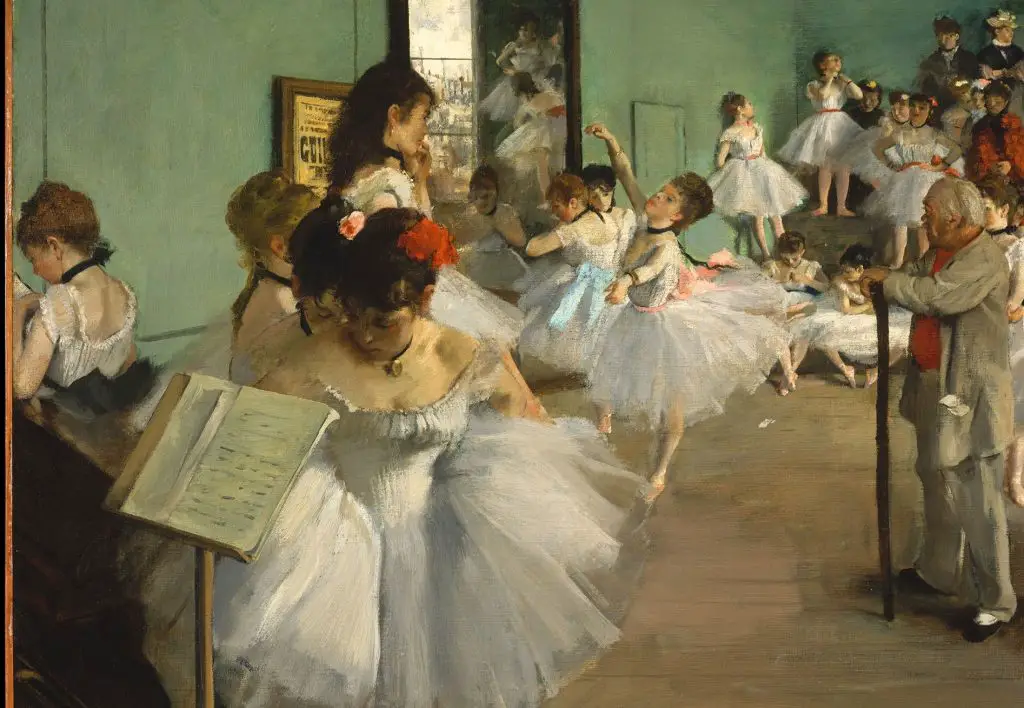
Many people love the beauty of ballet but don’t know much about its history. Edgar Degas was a painter who showed us what life was like for ballet dancers in Paris. 2
This blog will take you through his artwork, revealing truths and showing the grit behind the glamour. 1 Get ready to see ballet through Degas’s eyes. 3
Key Takeaways
- Edgar Degas captured the real life of Paris ballet dancers in his art, showing their hard work and tough conditions. He created over 1,500 pieces focused on ballet.
- The Palais Garnier opera house had dark secrets where ballerinas faced abuse from wealthy men. Degas didn’t ignore these harsh realities in his paintings.
- His technique of using lines and colours changed how artists after him thought about movement and art. He influenced modern art greatly.
- La Petite Danseuse,” a sculpture by Degas, tells the story of Marie van Goethem, a young dancer with a difficult life that illustrates the struggles behind ballet’s beauty.
- Through his artwork, Degas lets us see beyond the dance to understand both the talent and struggle of ballet dancers in 19th-century Paris.
Table of Contents
Edgar Degas and His Fascination with Ballet Dancers
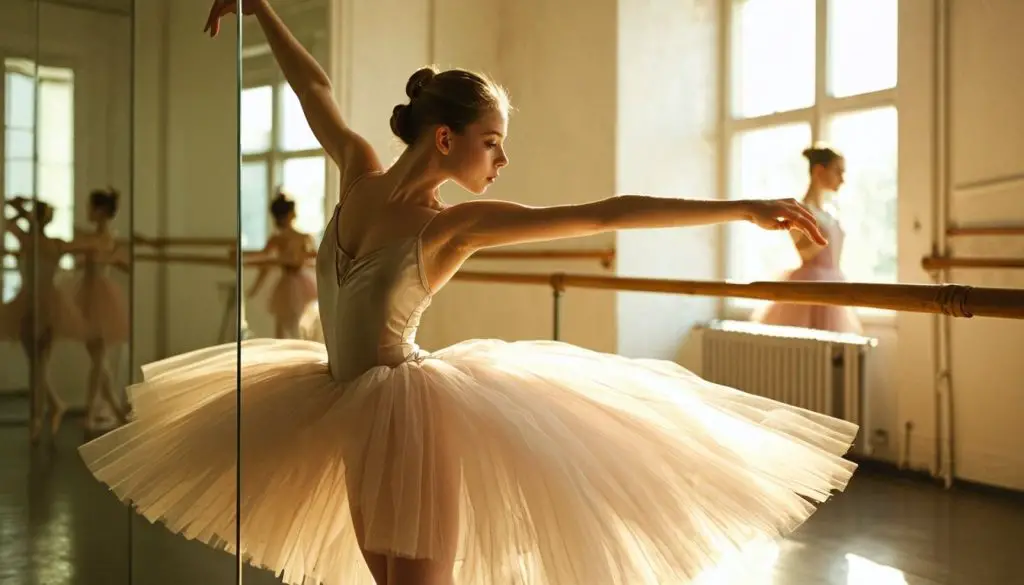
Edgar Degas loved watching ballet dancers. He often went to the Paris Opera House to see them perform and used these experiences as inspiration for his artwork.
The Sordid Truth Behind His Ballerina Paintings
The Palais Garnier, a grand opera house in Paris, hid dark secrets in its “foyer de la danse”. This room served as a meeting place where wealthy men could socialize and make propositions to ballerinas.
Many of these dancers came from poor backgrounds, enduring hard work for six days a week. They found themselves at the mercy of these powerful subscribers. These grim realities were captured by Edgar Degas in his ballet paintings. 1
Degas’s art often showed figures lurking in the background during rehearsals and behind-the-scenes moments. These sinister figures represented the harsh truth behind the beauty of ballet at that time.
The artist didn’t shy away from depicting these scenes, making them an essential part of understanding his work with dancers. 2
The Artistry of Degas Ballet Dancers
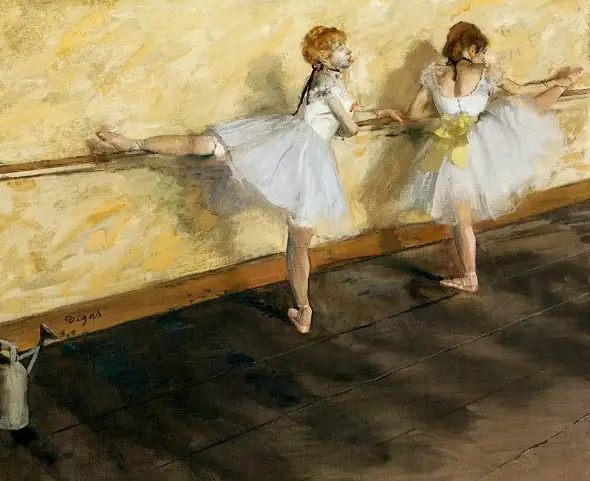
Degas captured the beauty and movement of ballet with his skilled brushwork, showing dancers in action and at rest. Keep reading to see how he brought Parisian dance to life on canvas.
Depicting Movement and Pretty Clothes
Edgar Degas used implied lines and a mix of bold and soft brushwork to show dancers in motion. His paintings often look like quick photos, capturing ballet dancers mid-move or at rest. 3
He loved vibrant colours as well as soft pastels and muted tones. This showed off the pretty costumes and lively scenes of Paris opera ballet. 4
Next, Degas turned his focus to creating intimate sketches dedicated to ballet. These drawings reveal his thorough exploration of the lives of dancers behind the curtain.
Intimate Drawings Dedicated to the Ballet
Degas dedicated over 1,500 pieces of his art to capturing the essence of ballet dancers. 3
These works range from oil paintings to sculptures, but it’s his sketches that truly stand out for their intimacy.
In these drawings, Degas explored the contours and movements of dancers with simple lines that speak volumes.
He used a technique where lines followed shapes closely, bringing out each dancer’s unique pose and motion. 5
These intimate drawings show not just the glamour but also the hard work behind the scenes in the ballet world.
Degas’s keen eye caught moments rarely seen by others—dancers at rest, practising, or simply waiting in the wings.
This dedication to showing all facets of ballet life made him not just an observer but a part of that world himself.
Moving next into how these depictions influenced modern art reveals even more about Degas’s lasting impact on both fields.
Influence on Modern Art
Edgar Degas’s work with ballet dancers did more than just showcase the beauty of dance. His use of line, colour, and motion changed how artists approached their craft. Modern artists learned from Degas.
They saw new ways to show movement in art. His methods also pushed them to try different colours and techniques in their pieces. 3
Degas had a big impact on contemporary art, especially through his ballet scenes. Artists after him looked at his drawings and paintings for inspiration. They noticed his unique style of capturing life and movement.
Because of this, the way modern art looks today owes a lot to Edgar Degas’s dedication to studying dancers at work and play. 6
The Story of La Petite Danseuse de Degas
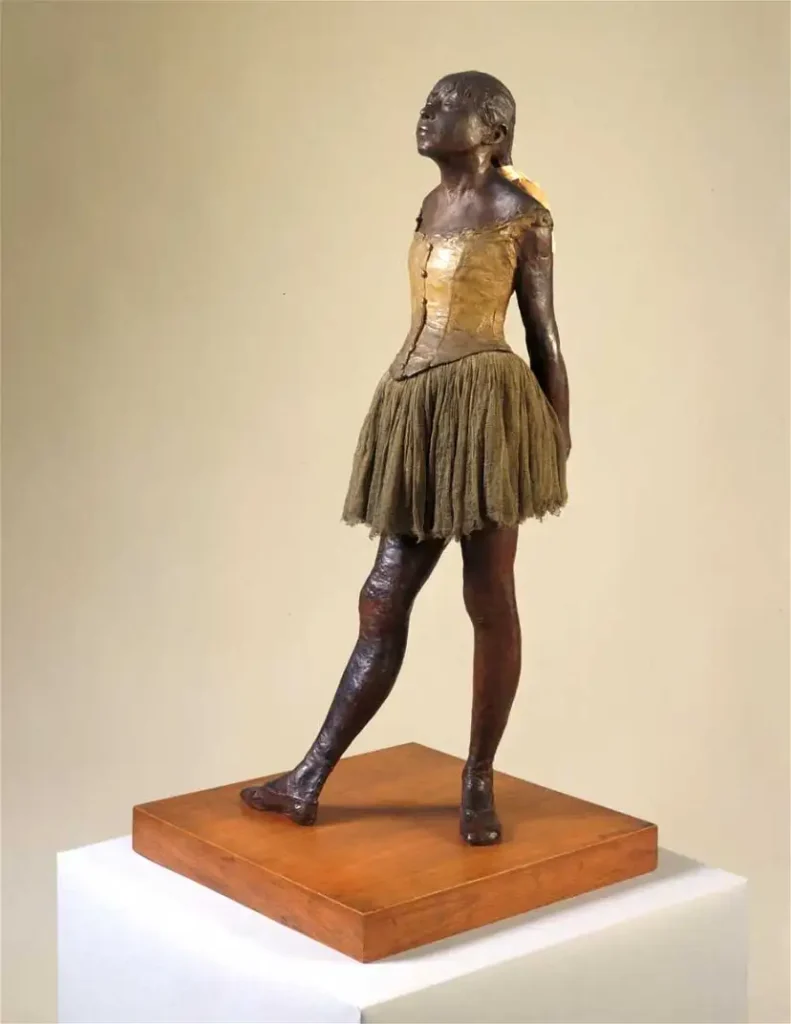
Degas’s sculpture, “La Petite Danseuse,” first showed up at Palais Garnier and caught everyone’s eyes. The girl who modelled for it had a tough life but became immortal through art.
Premiere at Palais Garnier
The new ballet “La Petite Danseuse de Degas” made its grand debut at the Palais Garnier. This performance, inspired by Edgar Degas’ famous sculpture, is a mix of old and new styles.
It features both classical and contemporary dance moves. In this ballet, the Little Dancer shines as an étoile, a star dancer on stage. 6Degas appears in the story as a shadowy figure, adding mystery to the show.
His presence links his artistic vision with live performance. Viewers get to see his art come to life in a unique way that combines history with creativity. 7
After being let go from the ballet school, Marie vanished from public view.
Her life illustrates the struggles within this demanding art form and how deeply Degas explored these dancers’ worlds.
Marie’s story is a stark reminder of what lay beneath those elegant performances at Palais Garnier – a reality far removed from the glittering stages she once graced. 8
The Legacy of Degas’ Ballet Dancers
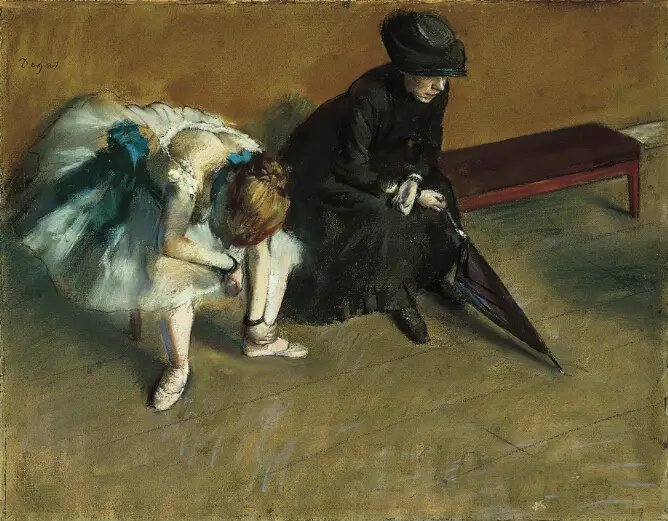
Degas’ art shows the beauty and effort of ballet in a way that still touches people today. Artists around the world look at his work, seeing how he caught movement on canvas, and feel inspired to capture similar magic.
Degas in the Eyes of Other Artists
Artists like Manet, Cézanne, Monet, and Renoir saw Degas as a realist. 1 They noted he chose scenes with ballet dancers and people from less wealthy backgrounds.
His art stood out because it was different from the bright and easygoing paintings of his peers.
Even though some of them created light-hearted scenes of leisure, Dens focused on the grittier aspects of Parisian life. This choice set him apart.
His sculpture of a young dancer stirred up quite the controversy. 6 After that, he stopped showing his sculptures to the public.
Despite this setback, his influence on these fellow artists remained strong.
They admired how he captured movement and depicted everyday life with such honesty and detail.
The Dark Underbelly of His Dancer Paintings
Degas’s ballerinas seemed to float on stage, but their lives were far from light. Many dancers came from poor families and endured long hours of work.
Degas captured this struggle, showing the tough reality behind the ballet’s beauty.
His art lets us see past the dance, into a world where young girls faced abuse and hardship. 1
His sculpture “Little Dancer Aged Fourteen” shocked people in 1870s Paris. It pushed boundaries by revealing what others preferred to ignore: a young dancer’s life full of challenges.
Degas didn’t just paint pretty pictures; he used his artwork to tell true stories about these dancers’ lives at the Opera and Ballet, shedding light on their suffering and resilience. 10
A Closer Look at Iconic Works
Moving from the darker aspects, let’s explore Degas’ celebrated pieces. His artwork, such as “Ballet at the Paris Opera,” showcases his unique approach to capturing ballet. 3 The use of translucent layers of pigment brings out stunning colours and depth.
Each piece holds dimensions like 28 x 26 in., framed beautifully at 35 3/4 x 34 x 2 1/2 in.
The journey these artworks took is fascinating. Ambroise Vollard first owned them before passing through Theodore Schempp’s hands. Eventually, they found a home at the Saint Louis Art Museum. 1
Seeing these works up close offers a direct experience of Degas’ masterful techniques and a deep appreciation for ballet dancers’ beauty and grace.
Appreciating the Beauty and Talent of Ballet Dancers through Degas’ Art.
Degas captured the grace and skill of ballet dancers in his art, showing the world their beauty. His paintings, like “Ballet at the Paris Opera” and “Dancer With a Bouquet,” invite us to see ballet through his eyes. 3
He painted dancers warming up, practising, and performing on stage. This gave viewers a peek behind the curtain at the Paris Opera Ballet—a place where only a few could go.
His work also reflects his thorough understanding of movement. By painting ballet dancers over and little by little, Degas got an intimate look at their world. 6
People who see his paintings can feel this closeness too. They get to appreciate not just the pretty costumes but also the hard work and talent it takes to be part of a corps de ballet.
Concluding Thoughts on Edgar Degas Ballet Dancers
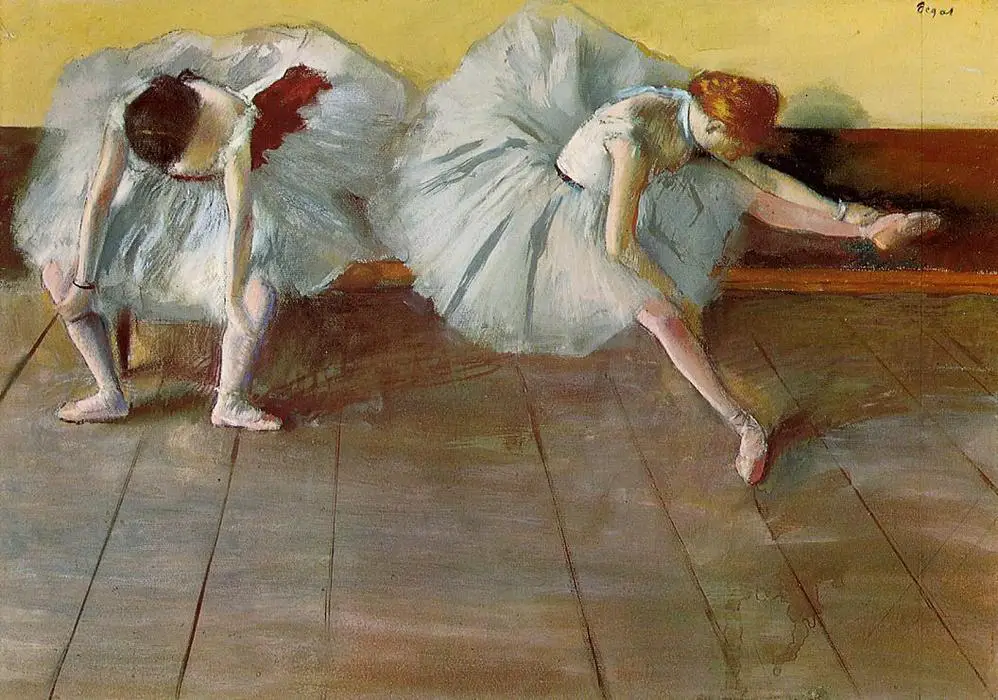
Exploring Edgar Degas’ ballet dancers has opened our eyes to a world both beautiful and dark. His art shows the hard life of ballerinas in stunning detail.
We see their grace but also learn about their struggles.
Degas captured moments that tell stories beyond dance steps and pretty costumes.
This journey through his vision reminds us of the power of art to reveal truths, pushing us to look deeper into what we admire.
Through these paintings and sculptures, we appreciate the beauty of ballet and the strength of those who danced in Degas’ time.
FAQs
1. What was Edgar Degas’ chief interest in his ballet paintings?
Edgar Degas, a renowned impressionist artist, had a keen interest in rendering movement and painting the pretty clothes of ballet dancers. His art reflects great attention to detail and captures the essence of classical ballet.
2. Can you tell me about some famous depictions of dancers by Degas?
One notable piece is “Dancers in the Wings,” housed at the National Gallery of Art. Another well-known work is “Two Dancers,” which can be found at the Philadelphia Museum of Art—both showcasing Degas’ unique ability to capture dancers from both formal and candid perspectives.
3. Did Edgar Degas have any personal connection with ballet or its dancers?
While it’s known that he spent significant time observing rehearsals, there’s no record indicating that Edgar himself ever joined the ballet corps as a dancer. However, his works suggest an intimate understanding of this art form.
4. Are all his artworks based on French Ballet?
Mostly yes! From drawings dedicated to ballet scenes to European paintings depicting graceful movements—his body of work heavily favours scenes from French Ballet.
5. Do any museums feature collections focused on Edgar Degas’s Ballet Paintings?
Yes indeed! The Metropolitan Museum houses several pieces including one titled “Four Dancers.” Similarly, The National Gallery has an extensive collection featuring many works such as “Dancer Comes” and “Curtsying Dancer Bathed.”
6. Did anyone else influence or contribute towards creating these masterpieces?
Art dealer Ambroise Vollard played a key role in promoting and selling many pieces crafted by Hilaire-Germain-Edgar-Degas during his lifetime.
References
- ^ https://www.artsy.net/article/artsy-editorial-sordid-truth-degass-ballet-dancers
- ^ https://www.cnn.com/style/article/edgar-degas-ballet-dancers-artsy/index.html
- ^ https://drawpaintacademy.com/ballet-dancers/ (2020-12-19)
- ^ https://canvas.saatchiart.com/art/art-history-101/capturing-movement-edgar-degas-and-his-dancers (2018-08-17)
- ^ https://www.nga.gov/research/publications/pdf-library/degas-the-dancers.html
- ^ https://www.smithsonianmag.com/arts-culture/degas-and-his-dancers-79455990/
- ^ https://www.medici.tv/en/ballets/la-petite-danseuse-de-degas-patrice-bart-world-premiere-opera-garnier
- ^ https://www.metmuseum.org/art/collection/search/196439
- ^ https://www.smithsonianmag.com/smithsonian-institution/true-story-little-ballerina-who-influenced-degas-little-dancer-180953201/
- ^ https://www.theguardian.com/artanddesign/2011/nov/15/john-berger-degas-ballet-dancers (2011-11-15)



Leave a Reply